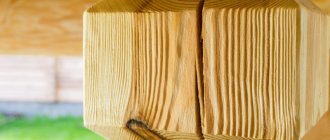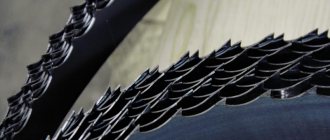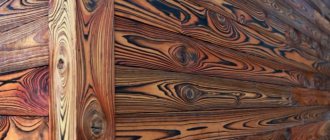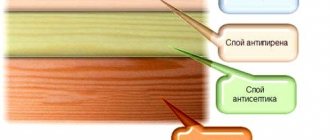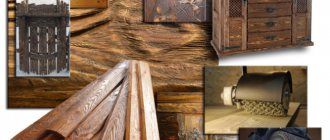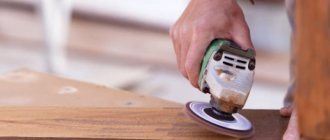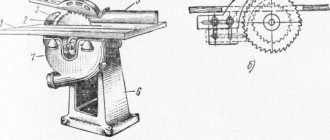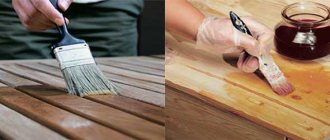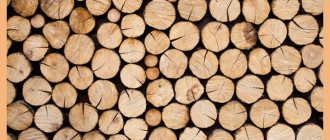Furniture and items made from old wood can be surprisingly attractive. But for the material to age naturally, many years must pass. You can significantly speed up this process if you use artificial aging technology - wood brushing. Let's look at how wood is aged, what types of wood are suitable for this, and what tools are used.
Brushed wood cannot be distinguished from truly old wood Source rubankom.com
What is wood brushing
Brushing is a technology for aging wood artificially. Using special tools, a relief surface is created, on which the growth rings become clearly visible. This creates the desired effect, the wood looks like old wood that has served for many years.
Anyone who is interested in what wood brushing is will know that the term comes from the word brush, which means “brush” in English. This is the tool that is used to remove soft fibers from the surface of wood. They form in a living tree in the spring, when its active growth begins.
The fibers are loose in structure, which is why they are more susceptible to abrasion than the hard rings that form in summer and autumn. This is how wood naturally ages, but it happens very slowly over many years. The purpose of brushing is to greatly speed up the process by removing soft fibers with a wire brush.
Furniture made from aged wood that can also be placed in a modern home Source happymodern.ru
Pine with an antique effect - brushing yourself
To give the desired shade, a variety of stains and impregnations are used and are chosen to suit any interior or exterior. Special impregnations help protect wood from rotting and various external influences if the product is used in outdoor conditions.
Brushing and burning wood are decorative finishing technologies. Methods allow you to preserve the pattern of the material, give the table an antique look, and change its shade.
Some impregnation manufacturers provide a guarantee of up to 15 years for two layers. Experience shows that at least half of this time the product actually remains protected.
What wood is suitable for brushing?
For brushing, you need to choose wood from trees of soft and medium hardness and with a structure that makes the growth rings clearly visible. Aged wood comes well from conifers: spruce, larch, pine, cedar and fir, as well as linden, aspen, willow, chestnut and alder.
On boards made of oak, walnut, birch, rowan, ash, you can also get the desired effect, but it will be less pronounced. It is more difficult or completely impossible to age wood from acacia, maple, yew, beech, teak, and pear. Brushing technology is ineffective for trees of tropical origin. They have practically no growth rings due to the climate.
In addition to boards, you can carefully brush veneered boards and lining. The small depth of immersion of the brush allows you not to destroy the surface, but to give expressiveness to the design.
This is what brushed lining looks like Source 1povagonke.ru
Wood aging methods
Artificial aging of wood is actively used by designers in creating unique interior projects. This popularity is explained simply: the wood retains all its physical characteristics, while acquiring a new, spectacular and original look.
There are three methods for aging wood:
- Mechanical – a wooden surface is either treated with a metal brush, as a result of which the soft top layer is removed and the texture becomes embossed (brushing); or tinting compounds are applied followed by sanding the board (patination). Often both methods are combined to obtain a more expressive texture and color of wood.
- Chemical - a special composition based on alkali or ammonia is applied to the surface, changing the color of the upper layers of hardwood.
- Thermal – lightly burning wood of any type with a torch, followed by sanding with a wire brush and tinting.
Hard wood species are suitable for brushing - oak, walnut, almost all conifers. Patination is used mainly on wood with a weak texture - beech, cherry, maple.
Despite its complexity, wood brushing technology today is one of the most popular among all types of decorative processing. It is used in the manufacture of antique-style furniture, parquet, wall and ceiling panels, doors, stairs, and flooring. Such decorative finishing is appropriate in the interior of apartments, cafes, shops, galleries, and studios. Aged wood adds expressiveness to any setting and hints at the “historicity” of the place.
Brushing tools
There are several ways to age wood. You can artificially age wood using:
- Hand tools. This is the simplest, but also the most labor-intensive method; its downside is that the process takes a lot of time. To perform brushing, a brush with stiff metal bristles is used. With the manual method, the depth is small, which must be taken into account when choosing wood for processing. This method is well suited for the production of single parts of small size.
- Electromechanical tool. This method is the most common, accessible and productive. It is universal, as it can be used not only in production, but also at home. Brushing is carried out using special machines or using a drill or grinder with brush attachments attached to them.
- Stankov. Wood is brushed on machines only in production conditions. They are designed for mass production of parts. The machine provides a full processing cycle; 3 brushes are used alternately: metal, removing fibers, grinding and polishing.
The choice of one or the other is influenced by the characteristics of the workpieces and the amount of work.
Grinder for brushing Source ad-cd.net
See also: Catalog of round log house projects
Chemical method
They are produced to facilitate the process of removing soft fibers, practically without the use of mechanical force. Chemical solutions have the ability to dissolve or soften wood fibers. Acids and some alkaline compounds are used. If you use products with a high concentration of active substances, then do without further use of brushes, just apply and rinse off the solution in several passes.
Work on this method must be carried out in the open air, as harmful and pungent odors are released.
All further processing is carried out in the same sequence as during mechanical finishing.
How does brushing work?
The wood brushing process consists of 3 successive stages. Each of them uses brushes made of different materials. Processing always goes along the fibers.
Brushing sequence:
- Treating the wood surface with a brush with metal (steel or brass) bristles. It effectively cuts and removes soft fibers, resulting in a textured relief on the surface.
- Sanding wood with a brush with nylon bristles coated with abrasive. The treatment removes damaged fibers, smooths out sharp edges and cleans out lint in recesses.
- Polishing with a soft sisal bristle brush. This stage completes the brushing of the wood and gives the product its final look.
The speed of fiber removal, relief depth and processing performance depend on the stiffness of the bristles of the metal brush. Therefore, for boards or workpieces made of hard wood, you need to choose stiffer brushes.
Wood surface after brushing Source www.comfortclub.ru
Other brushing methods
In addition to the main one, there is another industrial, but less popular way to age wood. This is sandblasting, in which brushing is carried out not with brushes, but with a jet of sand supplied under pressure. It is possible to obtain a deep relief with soft differences, without additional sanding.
Wood is also aged chemically, using strong acids or alkalis, ammonia, which can corrode cellulose. This method is used either on its own or as a first step prior to processing with metal brushes.
To age the wood and give it an original look, special firing is used. The material is scorched with a blowtorch or gas torch, the charred layer is moistened with water, then cleaned with a brush, removing all excess, and the surface is impregnated with oil or varnish to complete the processing.
Burnt and brushed wood Source 7dach.ru
See also: Catalog of companies that specialize in garden furniture and facade materials
Coloring or tinting
To give wood a more impressive appearance, staining or tinting is usually done.
To do this, use a water-based stain.
- The coating is done with a brush or sponge; it is important to carefully rub the tone along the fibers.
- If, during painting, fluff is visible that rises during the processing process, then it is necessary to stop the process, dry it and sand the wood again.
- Only after this can painting be continued. It is permissible to use complex methods of color changing, which are performed strictly in accordance with the instructions.
Brushing wood is called a great way to change the ordinary appearance of the material.
As a result of step-by-step preparation, the product receives a unique charm. Such items become a real highlight of the interior, a luxurious addition to it.
Brushing at home
Aging wood is not a simple process, but it is not such a complicated process that you can’t do it yourself. You will need material, simple tools, free time and a desire to work to make a beautiful product.
What is needed for brushing
Brushing brushes with steel or brass bristles can be used as brushes for brushing. To make the surface more uniform, it is better to choose brushes that are similar in shape to a roller or those that have a wider end side. The main work will be done with these brushes.
For the next stage - sanding the fleecy and rough surface - you will need a brush with synthetic nylon bristles with abrasive inclusions. After treatment with such a brush, the surface of the wood will acquire a more attractive appearance and will be prepared for polishing. And finally, for final processing you need to purchase a brush with coarse wool or sisal bristles. After using it, the wood will become perfectly smooth.
Electrical tools include a drill or an angle grinder. You should definitely get gloves and glasses; gloves will protect your hands from possible damage, glasses will protect your eyes from lint that may get into them.
Various brushes for brushing Source do.ngs.ru
Show sugi ban
The worldwide term for what is known in Japan as yaki-sugi-ita (or simply yakisugi), which literally translates to “burnt cedar board.” Although "sugi" colloquially means cedar in English, it is actually Cryptomeria japonica, a species of the cypress family native to Japan.
It's a counterintuitive but brilliant idea: burning boards to make them fireproof. If you've ever tried to start a fire using charred firebrands, you get the idea. Combustion destroys the cellulose in the wood.
These are carbohydrates that insects, fungi and bacteria love. Fire makes lumber uninteresting to pests and resistant to rotting. The resulting carbon layer repels water and protects from the sun. According to some estimates, boards that go through this process can last 100 years or more.
Video description
You can see how brushing is done at home in the video:
After processing
After the aging of the wood is completed, you can leave the processing at this stage or continue it: using various tools, for example, a drill, an awl and a hammer, make holes in the board that imitate traces of insects, make cracks on knots, scratches, dents, etc. e. fill some holes with putty, simulating dust accumulations. After this, paint the wood, cover it with stain, wax or varnish.
This is what brushed and painted boards look like Source e-brus.ru
Coating with different compositions protects the surface from harmful influences and extends the service life of the product. The painted surface becomes more textured, the pattern appears more clearly: the recesses become darker in color, and the ridges become lighter.
Burning
Processing wood using a combined method (firing + brushing) allows you to obtain unusual decorative effects. To do this, they first go over the workpiece with a gas torch or blowtorch. By adjusting the flame supply and the number of passes, you can get different shades from light yellow to completely black.
After firing, brushing is performed. The annual rings will remain dark from firing, and light veins will appear in place of the removed soft fibers.
The method of firing with hot (200 ºС) sand is also used. To do this, wooden blanks are placed in the latter until they darken, after which they are brushed.
Where is brushed wood used?
The bulk of the brushed material is used for the production of furniture and other interior items, and is used for interior decoration.
The use of brushed wood in the interior Source ratatum.com
From such wood you can make any “antique” furniture: cabinets, chests of drawers, beds, shelves, etc., cover the walls with panels made of aged wood, renew the floor, decorate the fireplace with a shelf made of it. Brushed wood is used to make small decorative items, such as jewelry boxes.
Beautiful box in country style Source yandex.net
Artificially aged wood can be used as a finishing material not only for residential buildings, but also for bars, restaurants, billiard halls, cafes and similar establishments. They will help create a unique, cozy atmosphere.
What mistakes are often made at work? Adviсe
Working with wooden blanks requires care and attention. Sometimes defects obtained during work are very difficult to correct.
- It is important to use high-quality and proven varnishes and paints. The same goes for etching chemicals.
- A common mistake: they do not allow the already applied layers of paint to dry completely and begin further processing. Information about curing times is indicated on the paint cans.
- Be sure to take into account the air temperature and relative humidity. The drier and warmer it is, the faster varnishes or paints will dry.
- Before using varnish, surfaces should be thoroughly cleaned and dirt removed.
Working with wooden workpieces requires care and attention.
Sources
- https://LesoBirzha.ru/articles/brashirovanie-drevesiny-sovety-byvalogo-stolyara.html
- https://metnor.ru/stroitelstvo/brashirovanie-drevesiny-metody-instrument-i-oborudovanie-shhetki
- https://proffstroygroup.ru/dekor/brashirovanie-dereva.html
- https://ArmRinok.ru/oborudovanie/broshyurovka-dereva.html
- https://drevesina.net/brashirovanie-drevesiny-obshhie-svedenija-i-osnovnye-jetapy/
- https://tehno-gid.net/inf/brashirovanie-drevesiny-chto-eto-za-tehnologiya-i-mozhno-li-obrabotat-derevo-samomu.html
- https://stroyizdereva.ru/chto-takoe-brashirovanie-drevesiny/
- https://stroy-okey.ru/house/interier/brashirovanie-drevesiny-svoimi-rukami-poetapnoe-rukovodstvo/
- https://sdelai-lestnicu.ru/besedka/obrabotka-dereva-pod-starinu-svoimi-rukami-sposoby-foto-video
Compliance with safety regulations
Brushing must be done in protective clothing, special glasses and gloves, and when using chemical solutions or the accumulation of large amounts of dust, in a respirator. You should also be careful when working with machines.
We hope that our master class and your imagination will help you make unique things that will be the subject of admiration for everyone around you, will make the interior of your rooms original and refined, and will last for many years, delighting the owners and guests of the house with their appearance.
Why is it necessary?
Why is brushing necessary? It's simple. Structured wood is one of the most popular materials used for cladding rooms for any purpose. Thanks to such cladding, the interior acquires original charm and uniqueness.
However, wood in its original form is not suitable for implementing the ideas of classic and vintage decor, as well as Provence.
The use of aged wood would be appropriate here; it can be used to make chests of drawers, tables, stylish doors and window frames, as well as for facing fireplaces and making decorative items. In former times, to obtain the necessary texture, logs were buried in the ground for many years.
During this time, under the influence of moisture and microorganisms, the soft fibers of the upper layers rotted a little, after which the workpieces were cleaned and sanded.
As a result, a relief texture of annual rings appeared on the surface. However, original patterns on the surface of wood under natural conditions are formed very slowly, and the aging process of the material is delayed for many years.
In addition, under the influence of precipitation, wind, ultraviolet radiation and temperature fluctuations, the material becomes less dense and durable, it is easily subject to rotting, deformation and destruction.
That is why nowadays they often resort to brushing, that is, artificial aging of wood. Moreover, interest in this technique is shown not only by lovers of vintage products, but also by supporters of eco-style in the interior.
Is it really that simple?
No, not all of them. Of course, if a small part is being textured, for example, the lid of a wooden box, there will not be any particular difficulties. But when processing large surfaces or mass production of parts, a technology that seems simple at first glance reveals many pitfalls.
What should you be prepared for?
When working with large volumes of wood, the performance of a conventional drill or angle grinder is often not enough. Working under wear increases the likelihood of tool failure. This problem is partly solved by reducing the speed, but this is reflected in a decrease in process productivity.
Holding a tool operating at maximum speed requires considerable physical effort. The brushing process itself is very long and requires constant monitoring, otherwise the uniformity of the relief cannot be guaranteed; Another common defect is the appearance of burns.
Working with resinous wood has its own specifics. Due to high friction, brushing brushes heat up the surface being treated. This leads to resin bleeding, which adds headaches during the work and finishing stage.
Technology advantage
Brushing wood has long been mastered by large woodworking enterprises, but is also available for small industries or individuals. The simple technique of the process allows you to do all the work with your own hands and people without practical skills.
From cheap and accessible lumber, you can create a skillful imitation of expensive finishes. With visual perception, you will have the feeling that in front of you are exotic types of wood, instead of the usual lining, an old barn board will suddenly appear, a sheet of plywood will turn into a valuable ornamental material.
Processing antique wood by brushing provides a wide range of possibilities for playing with color. Painted surfaces can look dusty, covered in cobwebs and mold, or come in extravagant color combinations.

